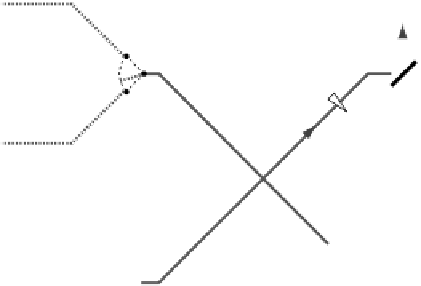Cryptography Reference
In-Depth Information
reasons an experimental demonstration of this reconstruction protocol would
be extremely difficult to achieve using existing technology.
Reconstruction Protocol
Using a Feedforward Loop
An alternative reconstruction protocol for
8.4.2.3
{
2,3
}
and
{
1,3
}
that simplifies the
orginal scheme by replacing the phase sensitive amplifiers with linear op-
tics and electro-optic feedforward (Figure 8.7) was proposed by Lance et al.
[19]. In this protocol the shares are interfered on a 2:1 beam splitter. The
beam splitter reflectivity is chosen so that the magnitudes of the noise fluc-
tuations (due to the entangled state and noise contributions) on each of the
two shares are equal on the beam splitter output
b
. With a correctly chosen
relative phase between the input beams, the noise fluctuations on the phase
quadrature of
b
are cancelled and the phase quadrature of the secret state is
reconstructed. The noise on the amplitude quadrature of
b
is increased by
this process. This noise can be cancelled, however, since it is correlated with
noise on the amplitude quadrature of
c
. By detecting
c
and feeding forward
the resulting photocurrent to displace the noise
b
, it is possible to cancel this
noise and simultaneously reconstruct the amplitude quadrature of the secret
state. Typically, in feedforward schemes, the fluctuations are directly applied
to the optical field using an electro-optic modulator. This method can be quite
inefficient, resulting in high losses. A more efficient method is to apply the
fluctuations to a separate intense beam (a strong local oscillator) and then
interfere this beam with
b
on a highly reflective beam splitter, as shown in
Figure 8.7.
{
2,3
}
and
{
1,3
}
player 1
{1,3} and {2,3}
ψ
out
HR
φ
φ
b
player 2
AM
2:1
G
LO
c
player 3
Figure 8.7
reconstruction protocols for the (2,3) quan-
tum state sharing scheme using linear optics and electro-optic feedforward. G: elec-
tronic gain;
Schematic of the
{
2,3
}
and
{
1,3
}
ψ
out
: reconstructed quantim state; AM: amplitude modulator; LO: optical
local oscillator; HR: high reflectivity; 2:1: 2/3 reflectivity beamsplitter;
φ
: phase delay.











































